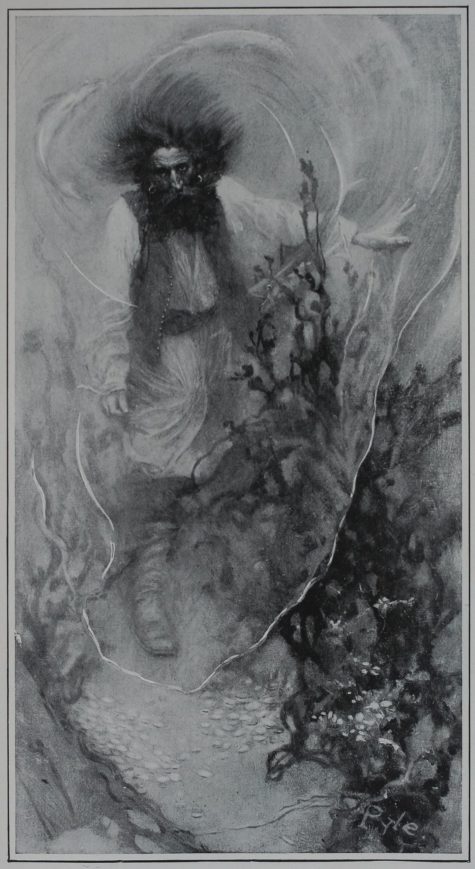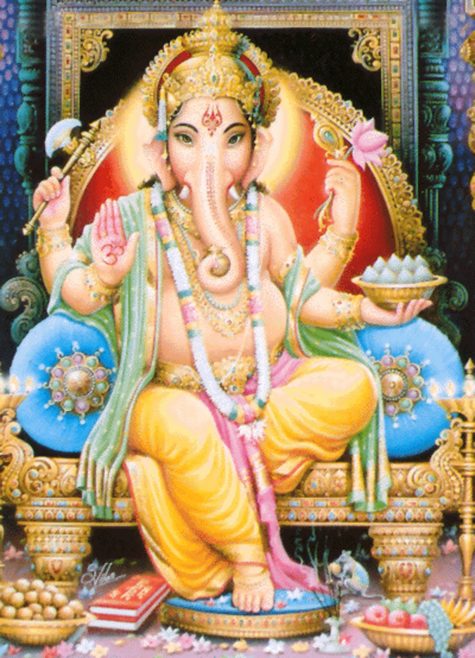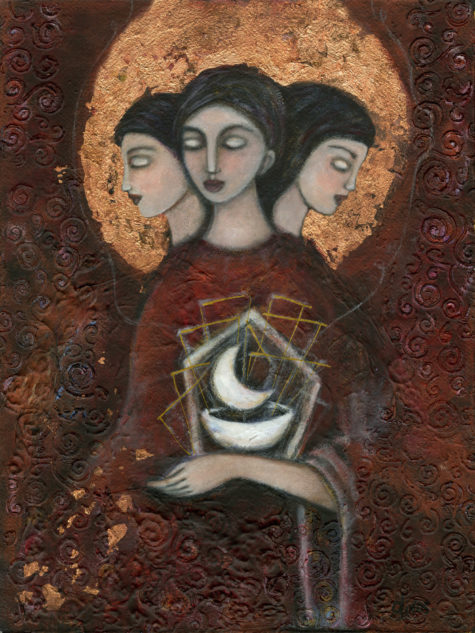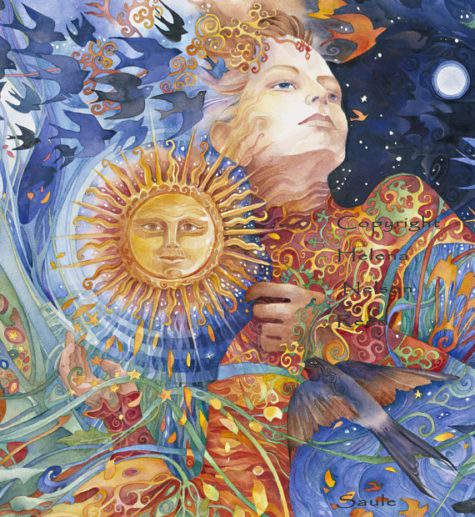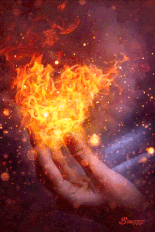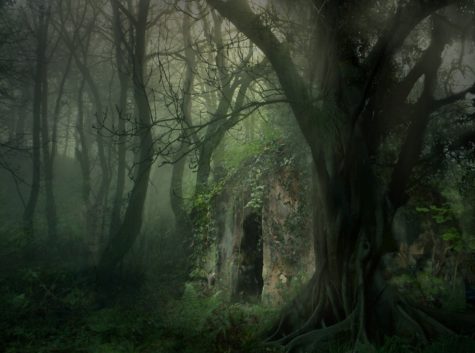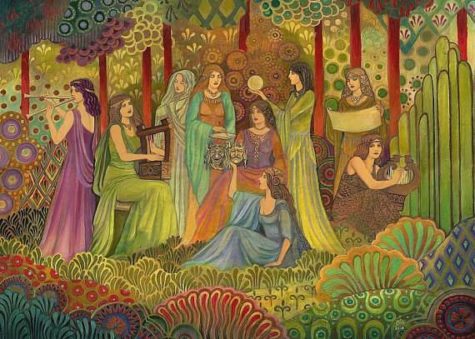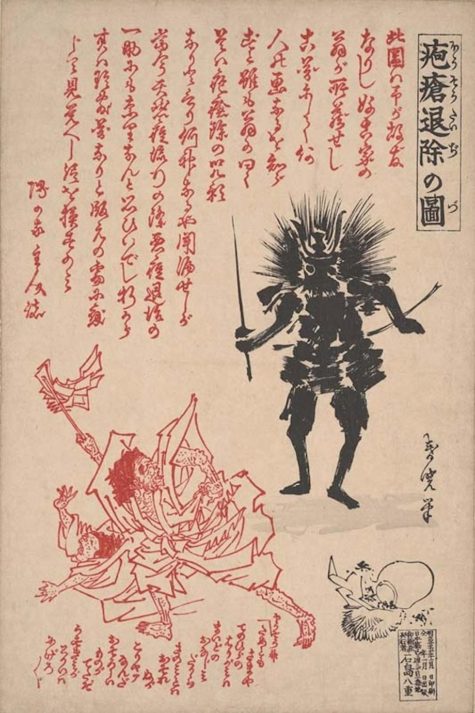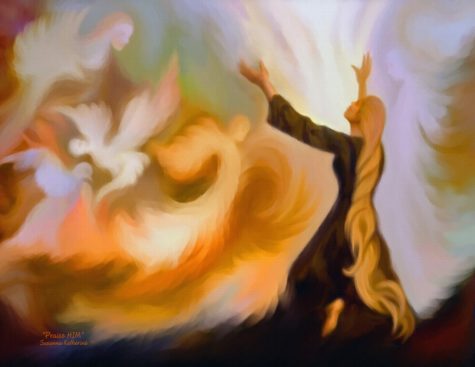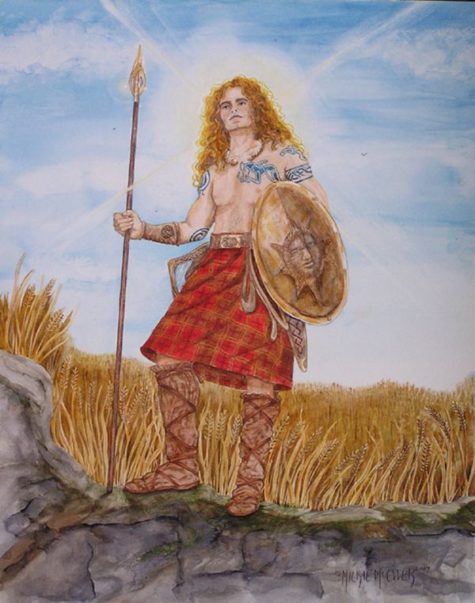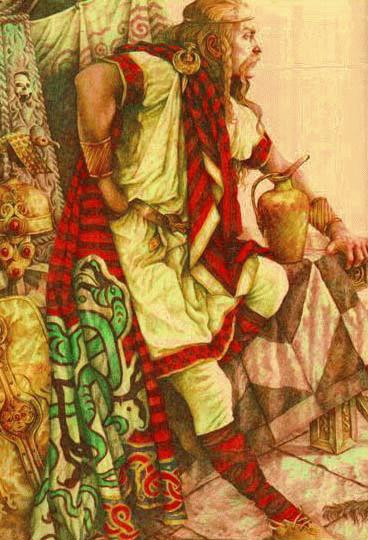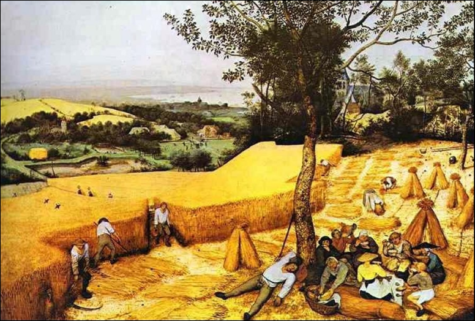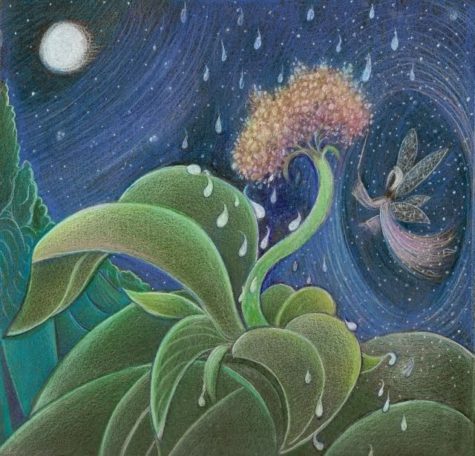Yearly Archives: 2017
A revenant is an animated corpse typically possessed by a spirit that was believed to return from the grave to terrorize the living. The word “revenant” is derived from the Latin word, revenans, “returning” (see also the related French verb “revenir”, meaning “to come back”).
Vivid stories of revenants arose in Western Europe (especially Great Britain, and were later carried by Anglo-Norman invaders to Ireland) during the High Middle Ages. Though later legend and folklore depicts revenants as returning for a specific purpose (e.g., revenge against the deceased’s killer), in most Medieval accounts they return to harass their surviving families and neighbors. Revenants share a number of characteristics with folkloric vampires.
Many stories were documented by English historians in the Middle Ages. William of Newburgh wrote in the 1190s,
“It would not be easy to believe that the corpses of the dead should sally (I know not by what agency) from their graves, and should wander about to the terror or destruction of the living, and again return to the tomb, which of its own accord spontaneously opened to receive them, did not frequent examples, occurring in our own times, suffice to establish this fact, to the truth of which there is abundant testimony.”
Stories of revenants were very personal, always about a specific individual who had recently died (unlike the anonymous zombie depicted in modern popular culture), and had a number of common features.
Source: Wikipedia
Here, one member of the group makes up a sound, call or statement and shouts it out, and the rest of the group shout it back at them. This can be especially effective as a kind of freeform invocation, for example, if everyone is familiar with the qualities, attributes and features of a particular God or Goddess. It can also be used as light-hearted introduction to designing invocations.
This form of repetition is commonly used in tantrik ritual, as salutations given to the god who is the object of the ritual. The example below is just a few of the 108 ritual salutations to the god Ganesha:
Salutations to him who has an elephant’s face
Salutations to him who wields the mace
Salutations to the son of Gauri
Salutations to the lord of planets
Salutations to him who transcends all qualities
Salutations to him who is lion-like
Continue until you have shouted out all the attributes you can think of. Follow the shout out with a humming meditation:
Each member of the group sets up a humming note, which can change in tone and power at will. The seed sound for the Ganesh Mantra could also be used: Gum gum gum gum… etc .The Humming should be kept up for at least 20 minutes for people to feel the effects of it.
Alternatively, it could be a shout out to the Goddess. Hecate for example:
All Hail the Queen of the Crossroads
All Hail the Mistress of the Underworld
All Hail Holder of the Keys
All Hail She Who Serves
Continue until you have shouted out all the attributes you can think of. This could be followed with a humming meditation as above, or a group chant to the specific deity. Here’s a chant to Hecate:
Hecate, Dark Mother, take us in
Hecate, Dark Mother, let us be reborn!
How do you get God’s attention?
Try sweet talking his girlfriend!
An amazing prayer by Rob Breznsy:
This is a perfect moment. It’s a perfect moment because I have been inspired to say a gigantic prayer. I’ve been roused to unleash a divinely greedy, apocalyptically healing prayer for each and every one of you, even those of you who don’t believe in the power of prayer.
And so I am starting to pray right now to the God of Gods, the God beyond all Gods, the Girlfriend of God, the Teacher of God, the Goddess who invented God.
Dear Goddess, you who never kill but only change: I pray that my exuberant, suave, and accidental words will move you to shower ferocious blessings down on everyone who reads this benediction. I pray that you will give them what they don’t even know they need, not just the boons they think they want but everything they’ve always been afraid to even imagine or ask for.
Dear Goddess, you wealthy anarchist burning heaven to the ground: Many of the divine chameleons out there don’t even know that their souls will live forever. So please use your brash magic to help them see that they are all wildly creative geniuses too big for their own personalities. Guide them to realize that they are all completely different from what they’ve been led to believe about themselves, and more exciting than they can possibly imagine. Make it illegal, immoral, irrelevant, unpatriotic, and totally tasteless for them to be in love with anyone or anything that’s no good for them.
O Goddess, you who give us so much love and pain mixed together that our morality is always on the verge of collapsing: I beg you to cast a boisterous love spell that will nullify all the dumb ideas, bad decisions, and nasty conditioning that have ever cursed the wise and sexy virtuoso out there. Remove, banish, annihilate, and laugh into oblivion any jinx that has clung to them, no matter how long they’ve suffered from it, and even if they’ve become accustomed or addicted to its ugly companionship. Please conjure an aura of protection around them so that they will receive an early warning if they are ever about to act in such a way as to bring another hex or plague into their lives in the future.
Dear Goddess, sweet Goddess, you sly universal virus with no fucking opinion: Please help all the personal growth addicts out there to become disciplined enough to go crazy in the name of creation, not destruction. Teach them the difference between oppressive self-control and liberating self-control. Awaken in them the power to do the half-right thing when it is impossible to do the totally right thing. Arouse the Wild Woman within them, even if they’re men.
Dear Goddess, you pregnant slut who scorns all mediocre longing: I pray that you will inspire all the compassionate rascals communing with this prayer to kick their own asses and wash their own brains. Provoke them to throw away or give away all the things they own that encourage them to believe that they are better than anyone else. Show them how much fun it is to brag about what they cannot do and do not have. Give them bigger, better, more original sins and wilder, wetter, more interesting problems. Most of all, Goddess, brainwash them with your freedom so that they never love their own pain more than anyone else’s pain.
Oh Goddess, you wildly disciplined, radically curious, shockingly friendly, fanatically balanced, mysteriously truthful, teasingly healing, lyrically logical master of rowdy bliss: I ask you to give your unconventionally unconditional love to all the budding messiahs who read this prayer; love them with all of your ocean and sky and fire and earth. Cultivate in yourself a fervent yearning for their companionship. Play with them every day. Answer their questions. Listen to their stories. Inspire them not just to nag you for what they want, but also to thank you for the uncanny gifts you flood them with. And if there are any pockets of ignorance or hatred these insanely poised creators might be harboring, any inadvertent idiocies that keep them blind to your blessings, please flush them out as soon as possible.
Dear Goddess, You psychedelic mushroom cloud at the center of all our brains: Bless all the inscrutable creators out there with lucid dreams while they are wide awake, and their very own spin doctors, and solar-powered sex toys that work even in the dark, and vacuum cleaners for their magic carpets, and a knack for avoiding other people’s hells, and a thousand masks that all represent their true feelings, and secret admirers who are not psychotic stalkers. Arrange for a racehorse to be named after them, or an underground river, or a boulevard in an exotic vacationland, or a thousand-year-old storm on Saturn or Jupiter. Teach them to push their own buttons and unbreak their own hearts and right their own wrongs and sing their own songs and be their own wives and save their own lives.
Dear Goddess, You fiercely tender, hauntingly reassuring, orgiastically sacred feeling that is even now running through all of our soft, warm animal bodies: I pray that you provide all the original sinners out there with a license to bend and even break all rules, laws, and traditions that keep them apart from the things they love. Show them how to purge the wishy-washy wishes that distract them from their daring, dramatic, divine desires. And teach them that they can have anything they want if they’ll only ask for it in an unselfish way.
And now dear God of Gods, God beyond all Gods, Girlfriend of God, Teacher of God, Goddess who invented God, I bring this prayer to a close, trusting that in these mysterious moments you have begun to change everyone out there in the exact way they’ve needed to change in order to become the gorgeous geniuses they were born to be.
Amen. Awomen.
From: How the Whole World Is Conspiring to Shower You with Blessings
The dark powers emanate from the dark aspects of the Goddess and the God. This is the power of the Crone and the Lord of the Shadows; the Hag and the Hunter. The dark powers are more than just a personification of the negative influences in life, however, and the energy raised through the dark imagery of the Divine is very potent. As such, be careful what you do.
The Dark Goddess is manifested in mythology as various kinds of death crones, wise hags, devastation, war, disease and barrenness of the land. She is the Bone Mother who collects the skulls of the dead for the ossuary. In Irish mythology, Morrigan and Nemain would be considered Dark Goddesses in that they are associated with War and Death.
The Dark God is seen in mythology as the silent host to the dead in his underground realm of gray shadows and deep sleep, knowing of secrets and wise of the universe, death, war, destruction, gatherer of souls and harbinger of chaos. He is the Hunter, whose wild hunt, or raid, ingathers the energies of the soul.
There is sense to this ancient cosmology. Cults of ancient times focused on the dark aspects of the Divine so that their followers would move past their fear of mortality to seize upon the recognition of their eternal immortality.
In Irish mythology, Crom Cruach, and Donn would be considered “Dark Gods” or “Dark Powers” because Donn was the god of the dead Milsians. At death, Mannannan Mac Lyr carried the soul to Tech Dunn or the House of Donn. In texts like the Dinsenchus there is references to Crom being considered to be a dark god, contrasting a light god, in a way that is very similar to the Slavic god Czernobog.
As a power, the Dark Lord is the Chaos from which Order must evolve. Yet there is no ending to this cycle, Order resolves again as Chaos to be reborn as New Order. The Lord of Shadows as Death becomes the process of new life by gathering the energy of dying life, and the Passage into a new material form is through the Crone.
In the aspect of light, the god dies willingly by entering the ground to bring his vitality to crops that will be harvested to feed humanity. Through this selfless act, he revitalises the earth. He does this through the Crone. The marriage of Lugh in August, celebrated as Lughnasadh, is the start of the descent into Mother Earth. Once there, he is transformed into the son within the goddess. Hence, the pagan god is both Father and Son, which is yet another concept that Christianity absorbed from the pagans. The harvest comes, the seasons change, and the Mother becomes the Crone of Autumn and Winter, only to be transformed into Mother again at Winter Solstice with the rebirth of the Sun (her son, the god). See Also: Cernunnos, Green Man and Herne.
The womb-tomb is the domain of the Crone and is a place of great power. This is where the transformation takes place, with energies of death given repose and returned to form as the energies of life. When this power is confronted and recognised, there comes a freedom from fear, a new sense of independence and a recognition of personal responsibility. We are not judged in Death by the Lady and the Lord, but we are Self-judged. From the quietude of the realm, we move through her into new life. That is the balanced, pagan theme of the cauldron, the god of self-sacrifice and the resurrecting goddess. It is this power of the goddess that significantly differentiates the old and new religions.
Thus, in an historical sense, while the Dark Lord guides the chaos of social and cultural changes through the Crone into a new life, the Crone becomes not the terror of death, but the joyful passage to new vibrant societies through the death of the outmoded and stagnant ones. She is Fata Morgana, the Huntress Diana, Minerva, Cerridwen, Sati and Kali. He is Pluto, Hades, Cerunnos, Herne the Hunter, Set and Shiva. But the names may not convey the image needed by the practitioner unless you are able to move beyond the modern association of darkness as evil.
By accepting that the dark powers are in balance with the light powers, you are able to utilise the wholeness of the Power. The dichotomy of good and evil do not apply to what simply is. Energy can be drawn to the light or to the dark; thus death provides the soul’s passage to whichever realm the soul-energy has been drawn. Energy is always in motion, and flows back and forth between light and dark. What at one time is light energy turns and becomes dark energy. Through the practice of the Craft, the witch directs this energy for beneficial purpose. To do otherwise, is to inflict Self-harm.
To face the Underworld and the power of the dark aspect of the Divine is to understand that dark is part of the necessary blend of light and not something to fear. The unifying of the dark and the light within the individual offers wholeness and peace, which may then be transferred to external contacts.
From: Green Witchcraft II
The Horae (Greek Goddesses of the hours) personified the twelve hours (originally only ten), as tutelary goddesses of the times of day. The hours run from just before sunrise to just after sunset, thus winter hours are short, summer hours are long. Here’s the list:
- Auge, first light
- Anatolê or Anatolia, sunrise
- Mousikê or Musica, the morning hour of music and study
- Gymnastikê, Gymnastica or Gymnasia, the morning hour of gymnastics/exercise
- Nymphê or Nympha, the morning hour of ablutions (bathing, washing)
- Mesembria, noon
- Sponde, libations poured after lunch
- Elete, prayer, the first of the afternoon work hours
- Aktê, Acte or Cypris, eating and pleasure, the second of the afternoon work hours
- Hesperis, evening
- Dysis, sunset
- Arktos or Arctus, night sky, constellation
An interesting practice to bring a deeper understanding of the Goddess energy, and a deeper connection to the rhythms of the day is to take a short moment to acknowledge each goddess at her approximate time. This can be as simple as a small salute or short hello. You might be pleasantly surprised at the magickal turn your life takes when you practice this consistently over time.
The Horae are the joyous goddesses of the seasons. Daughters of Zeus and Themis, they are spirits of abundance. The Horae organized the seasons and devised the earliest calendar, establishing the length of months, weeks, days, minutes, and hours. They are the goddesses of the correct movement, spirits of perfect timing.
They are the truthful ones who guard the gates of Olymus. Although described as the daughters of Zeus, legends suggest that they were the ones who raised Hera. (It’s been theorized that they were originally only Themis’ possibly parthogenic daughters. Later, when paternity became significant, Zeus was incorporated into the myth.)
In their earliest manifestations, there were only two or three Horae. Eventually, however, more joined them until there were twelve Horae. They are closely allied with Hera, Aphrodite, and Dionysus:
- The Horae open the gates of the sky for Hera.
- Hera can allegedly be contacted via the Horae. Contact them first and request that they intercede.
- The Horae are among those who greeted and clothed Aphrodite when she rose from the sea.
- They dance in the entourage of Dionysus.
- The Horae are Dionysus’ partners in viniculture, responsible for the ripening of grapes.
The blessings of the Horae are invoked on brides, weddings, and children.
The ancient Greeks did not have hours of fixed length as we do today. Instead they divided the hours of daylight into twelve portions identified by the position of the sun in the sky. Thus the length of the hour varied between the longer days of summer and shorter ones of winter.
The twelve Horai were not always clearly distinguishable from the Horai of the seasons who were also described as overseeing the path of the sun. From the Nonnus, Dionysiaca, a Greek Epic from the 5th century AD:
“The four Horai (Seasons) were greeted by the twelve circling Horai (Hours), daughters of Khronos (Chronos, Time), tripling round the fiery throne of the untiring Charioteer in a ring, servants of Helios that attend on his shining car, priestesses of the lichtgang each in her turn : for they bend the servile neck to the ancient manager of the universe.”
Sources:
- Origin: Japan
- Classification: Kami
- Color: Red
- Offerings: Rice with red adzuki beans
Hosogami are smallpox spirits. (Hoso is the Japanese word for smallpox.) For safe recovery to health, the Hosogami must be soothed, propitiated, and sent on their way. Hosogami are pleased to see the color red. Physicians were glad to see the color red too:
- Purple smallpox rashes indicate the illness is in a dangerous stage.
- If and when rashes turn red, the patient is expected to recover.
The person suffering from small pox and those caring for him dressed in red to appease the Hosogami. In addition, “red prints” or hoso-e prints, paper wall amulets were posted at the first hint of small pox to propitiate, avoid, and/or banish the illness.
Daruma and Shoki possess the power to expel Hosogami and are among the spirits portrayed on red smallpox talismans.They are called “red” because that’s the primary color of these prints. If no print is available, red banners may suffice.
Following the patient’s recovery, these prints were traditionally ritually burned or floated down rivers to signal the departure of the spirit. Extremely few survive and these are now extremely valuable collectors items.
Source: Encyclopedia of Spirits
In praying to most gods, the Greeks stood holding the arms upward. When praying to a sea god, the arms were held forward; to an Earth or underworld deity, the arms were held down toward the ground, at the same time stamping on the Earth to attract the deity’s attention.
In all ritual positions, they faced East. When praying in temples, they faced the altar and the deity’s statue.
From: Moon Magick
Lugh (pronounced LOO) was known to the Celts as a god of craftsmanship and skill — in fact, he was known as the Many-Skilled God, because he was good at so many different things. In one legend, Lugh arrives at Tara, and is denied entrance. He enumerates all the great things he can do, and each time the guard says, “Sorry, we’ve already got someone here who can do that.” Finally Lugh asks, “Ah, but do you have anyone here who can do them ALL?”
- Origin: Celtic
- Attributes: Magical spear, harp
- Bird: Raven
- Animal: Lion, horse
- Planet: Sun
- Plant: Red corn cockles
Lugh, Lord of Craftsmanship, Light, Victory and War, is a master builder, harpist, poet, warrior, sorcerer, metalworker, cupbearer and physician. It’s hard to envision anything at which Lugh does not excel.
- Also known as:
Lug, Luc, Lugos, Lleu Llaw Gyffes, Bright One of the Skillful Hand - Favored people:
Artisans, crafts people, poets, artists, physicians, soldiers, and warriors. - Manifestation:
Shining, handsome, charming and witty. He has a silver tongue to match his skillful hands. - Consorts:
Lugh has different consorts in different locations but he was frequently linked to Rosemerta. - Spirit Allies:
Lugh shared the city of Lyon with Kybele and Paris with Isis. In battle, Lugh used his own weapons but also those belonging to Manannan.
Lugh was venerated throughout the ancient Celtic world. Modern scholars perceive him as especially significant because his veneration indicates the existence of pan-Celtic spiritual traditions. (Celts once ruled a huge swathe of continental Europe before being forced to the very edges of the continent.)
At least fourteen European cities are named for Lugh including Laon, Leyden, Loudon and Lyon. Lyon’s old name was Lugduhum, meaning “Lugh’s Fort.” Tat city is believed to have been his cult center. Its coins bore the images of ravens which may be a reference to Lugh. Carlisle in England, the former Lugubalium, is also named in Lugh’s honor. Some theorize that Lugh’s name is reflected in an older name for paris: Lutetia.
The Romans identified Lugh with Mercury. Many European churches dedicated to Michael the Archangel are believed to have been built over sites once dedicated to Lugh. Post-Christianity many of Lugh’s sacred functions were reassigned to saints like Patrick and Luke.
Lugh apparently traveled westward through Europe. Irish and Welsh myths describe his first appearance in their pantheon. He is greeted with resistance from women in Wales. His first public act in Ireland is to join battle with the Tuatha De Danaan (his father’s people) against the Fomorian, his mother’s people. Lugh chooses allegiance with the paternal line; the myth may be interpreted as indicating the beginnings of patriarchy in Ireland.
- Feast: August 1st
August 1st is the festival of Lughnasadh. Lughnasadh (sometimes spelled Lughnasa) means “the marriage of Lugh.” Lugh the sun and the Earth Mother renew their wedding vows annually during the full moon in August and invite all to gather and revel with them. Lughnasadh celebrates the consummation of their sacred relationship.
Once upon a time, Lughnasadh was a four week festival.: the last two weeks of July and the first two weeks of August, roughly corresponding to when the sun is in Leo, the astrological sign that belongs to the sun and epitomizes its power. In modern Irish Gaelic, the month of August is Lunasa. However the modern Wiccan sabbat of Lughnasadh is almost always devoted solely to the eve of July 31 leading into Lughnasadh Day on August 1st.
Celebrating Lugh Today:
Lughnasadh is a pagan holiday is dedicated to this capable God, and is celebrated every year on August 1st.
Take the opportunity this day to celebrate your own skills and abilities, and make an offering to Lugh to honor him, the god of craftsmanship.
Here’s How:
Before you begin, take a personal inventory. What are your strong points? Everyone has a talent — some have many, some have one that they’re really good at. Are you a poet or writer? Do you sing? How about needlecraft, woodworking, or beading? Can you tap dance? Do you cook? How about painting? Think about all the things you can do — and all of the things you’d like to learn to do, and the things you’d like to get better at. Once you sit down and think about it, you might be surprised to realize how accomplished you really are.
Decorate your altar with items related to your skill or talent. If your skill relates to something tangible, like sewing or jewelry-making, put some of your craft supplies on the altar. If it’s an ability to DO, rather than MAKE, such as dancing or singing, put some symbol of your ability on your altar. Do you have a favorite outfit you wear when you dance? A particular song lyric that you know you’re fabulous with? Add as many items as you like to your altar.
You’ll need a candle to symbolize Lugh, the god. Any harvest color is good, because he came up with the idea of a grain festival to honor his foster mother, Tailtiu. Place the candle on your altar in the center. Feel free to add some stalks of grain if you like — you can combine this rite with one honoring the harvest, if you choose.
Light the candle, and take a moment to think about all the things you are good at. What are they? Are you proud of your accomplishments? Now’s your chance to boast a little, and take some pride in what you’ve learned to do.
Announce your own talents in the following incantation. Say:
Mighty Lugh, the many-skilled god,
he who is a patron of the arts,
a master of trades, and a silver-tongued bard.
Today I honor you, for I am skilled as well.
I am deft with a needle,
strong of voice,
and paint beauty with my brush strokes.*
*Obviously, you would insert your pride in your own skills here.
Now, consider what you wish to improve upon. Is your tennis-playing out of whack? Do you feel inadequate at bungee jumping, yodeling, or drawing?
Now’s the time to ask Lugh for his blessing. Say:
Lugh, many-skilled one,
I ask you to shine upon me.
Share your gifts with me,
and make me strong in skill.
At this time, you should make an offering of some sort. The ancients made offerings in exchange for the blessings of their gods — quite simply, petitioning a god was a reciprocal act, a system of exchange. Your offering can a tangible one: grain, fruit, wine, or even a sample of your own talents and skills — imagine dedicating a song or painting to Lugh. It can also be an offering of time or loyalty. Whatever it is, it should come from the heart.
Say:
I thank you, mighty Lugh, for hearing my words tonight.
I thank you for blessing me with the skills I have.
I make this offering of (whatever it is you are offering) to you
as a small token of honor.
Take a few more moments and reflect on your own abilities. Do you have faith in your skills, or do you deflect compliments from others? Are you insecure about your abilities, or do you feel a surge of pride when you sew/dance/sing/hula hoop? Meditate on your offering to Lugh for a few moments, and when you are ready, end the ritual.
Tips:
If you are performing this rite as part of a group, family or coven setting, go around in a circle and have each person take their turn to express their pride in their work, and to make their offerings to Lugh.
Sources: Encyclopedia of Spirits and PaganWiccan
When Lammastide rolls around, the fields are full and fertile. Crops are abundant, and the late summer harvest is ripe for the picking. This is the time when the first grains are threshed, apples are plump in the trees, and gardens are overflowing with summer bounty. In nearly every ancient culture, this was a time of celebration of the agricultural significance of the season. Because of this, it was also a time when many gods and goddesses were honored. These are some of the many deities who are connected with this earliest harvest holiday.
Adonis (Assyrian): Adonis is a complicated god who touched many cultures. Although he’s often portrayed as Greek, his origins are in early Assyrian religion. Adonis was a god of the dying summer vegetation. In many stories, he dies and is later reborn, much like Attis and Tammuz.
Attis (Phrygean): This lover of Cybele went mad and castrated himself, but still managed to get turned into a pine tree at the moment of his death. In some stories, Attis was in love with a Naiad, and jealous Cybele killed a tree (and subsequently the Naiad who dwelled within it), causing Attis to castrate himself in despair. Regardless, his stories often deal with the theme of rebirth and regeneration.
Ceres (Roman): Ever wonder why crunched-up grain is called cereal? It’s named for Ceres, the Roman goddess of the harvest and grain. Not only that, she was the one who taught lowly mankind how to preserve and prepare corn and grain once it was ready for threshing. In many areas, she was a mother-type goddess who was responsible for agricultural fertility.
Dagon (Semitic): Worshiped by an early Semitic tribe called the Amorites, Dagon was a god of fertility and agriculture. He’s also mentioned as a father-deity type in early Sumerian texts and sometimes appears as a fish god. Dagon is credited with giving the Amorites the knowledge to build the plough.
Demeter (Greek): The Greek equivalent of Ceres, Demeter is often linked to the changing of the seasons. She is often connected to the image of the Dark Mother in late fall and early winter. When her daughter Persephone was abducted by Hades, Demeter’s grief caused the earth to die for six months, until Persephone’s return.
Lugh (Celtic): Lugh was known as a god of both skill and the distribution of talent. He is sometimes associated with midsummer because of his role as a harvest god, and during the summer solstice the crops are flourishing, waiting to be plucked from the ground at Lughnasadh.
Mercury (Roman): Fleet of foot, Mercury was a messenger of the gods. In particular, he was a god of commerce and is associated with the grain trade. In late summer and early fall, he ran from place to place to let everyone know it was time to bring in the harvest. In Gaul, he was considered a god not only of agricultural abundance but also of commercial success.
Neper (Egyptian): This androgynous grain deity became popular in Egypt during times of starvation. He later was seen as an aspect of Osiris, and part of the cycle of life, death and rebirth.
Parvati (Hindu): Parvati was a consort of the god Shiva, and although she does not appear in Vedic literature, she is celebrated today as a goddess of the harvest and protector of women in the annual Gauri Festival.
Pomona (Roman): This apple goddess is the keeper of orchards and fruit trees. Unlike many other agricultural deities, Pomona is not associated with the harvest itself, but with the flourishing of fruit trees. She is usually portrayed bearing a cornucopia or a tray of blossoming fruit.
Tammuz (Sumerian): This Sumerian god of vegetation and crops is often associated with the cycle of life, death, and rebirth.
Elemental fairies (being one type of fairy) “are the thought-forms of the Great Beings, our angels, who are in charge of the evolution of the vegetable kingdom. When one of these Great Ones has a new idea connected with one of the kinds of plants or flowers which are under his charge, he often creates a thought-form for the special purpose of carrying out that idea.
It usually takes the form either of an etheric model of the flower itself or of a little creature which hangs round the plant or the flower all through the time that the buds are forming, and gradually builds them into the shape and color of which the angel has thought. But as soon as the plant has fully grown, or the flower has opened, its work is over and its power is exhausted, and, as I have said, it just simply dissolves, because the will to do that piece of work was the only soul that it had.
~C. W. Leadbeater:
